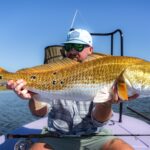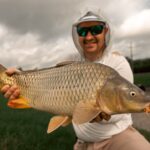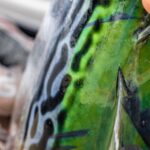
Louisiana Bull Reds Up for Harvest Again: H.B. 604 Must Not Pass
Photo Credit: Carter Abramson | Trevor Johnson Every now and then, we encounter something so
There was a conversation during last month’s ASMFC Winter Meeting that floated under the radar but has major implications for our striped bass fishery. On Thursday, one day after the Striped Bass Board met to finalize Addendum II, NOAA staff gave a presentation about state involvement and the outlook for aquaculture in the EEZ, as they seek opportunities to expand domestic aquaculture production.
Dr. Danielle Blacklock from NOAA started her presentation by saying, “I know that you had a busy meeting about striped bass, and that yesterday was probably a hard day for many. I’m hoping that aquaculture can be seen as part of the solution for some of the challenges you’re experiencing.” If that statement doesn’t send a shiver up your spine as a striped bass advocate, I think you need to reread it. Dr. Blacklock then went on to say NOAA is “actively receiving applications for Gulf of Mexico Waters to farm Atlantic Striped Bass”, before beginning her pitch to expand these efforts to the Atlantic EEZ.
Other key notes from the sales pitch include citing a dramatic increase in growth rates due to selective breeding, multiple known sterilization methods and an emphasis on a well-funded research consortium, StriperHub, that exists with “the goal of commercialization of striped bass”. The presentation ended acknowledging that on the Atlantic coast, there currently isn’t a legal pathway to proceed forward. “I’m not sure whether that’s on purpose or not,” Dr. Blacklock stated, “I just don’t know if when those rules were made, people weren’t thinking about farming Atlantic striped bass because the science wasn’t there – and now it is.”
First, Let’s lay some groundwork for this blog. We want to establish that this not an indictment of Dr. Blacklock and the NOAA Aquaculture team. We have no doubt there are a lot of brilliant minds at work behind the scenes and their intentions are not rooted in the fears we will relay below. At a very high level, we are not opposed to the concept of aquaculture as a means of producing food for a rapidly expanding global population. That being said, ASGA stands firm on a belief that the threats posed by farm-raised fish, whether hosted in open water in proximity to or intentionally used for the supplementation of wild populations, significantly outweigh any gains. We believe that the hatchery supplementation of overfished wild populations provides a cop out for managers failing to properly manage those stocks. This action is essentially putting a finger-sized bandaid on a bullet wound, which in turn develops a revolving bandaid market that thrives on the need for more wounds. And so, the wounded subject continues to bleed out while more bandaids are sold. How’s that for a gory metaphor to start your morning?

While there wasn’t a major emphasis on stock supplementation in this presentation, there have been many ill-conceived campaigns to bring it into the wild management conversation (some conversations even sparked but “established influences” in the realm of striped bass management). Louisiana Department of Wildlife and Fisheries just authorized a small hatchery operation for redfish in Louisiana. We will oppose any and all efforts to expand this. Further east across the gulf, Florida has been using hatchery redfish to supplement populations struggling with increasing fishing pressure and rapidly degrading habitat and water quality. This is where our fear lies. With the “death by a million” cuts our coastal striper population is experiencing (with the largest gash being fishing pressure), we can’t take any additional actions that put rebuilding this wild fishery at risk. Net pen aquaculture in Atlantic waters would certainly check that box.
The case of how much damage net pen aquaculture has imposed on our wild anadromous salmon populations stands as a “shining example” for what to avoid. If you haven’t seen “Artifishal: The Fight to Save Wild Salmon” from Patagonia Films from 2019, add it to the top of your movie list. It’s complete free and available for access on YouTube – click here. Striped bass managers have repeatedly shown an inability to learn from the past. We’re hoping they can look across the bow at domestic salmon fisheries and not invite more chaos into an already tumultuous situation.
Net pen aquaculture, the practice of raising finfish like salmon in giant pens located in open-water marine environments, poses significant threats to native populations and the surrounding marine ecosystems. One of the many primary concerns is the potential for disease transmission between farmed and wild fish. This has been a major issue for the salmon community. Crowded and condensed conditions within sea pens create an ideal environment for the spread of pathogens, such as viruses, compromising the health of both captive and wild fish. Escaped farmed salmon, carrying these diseases, can introduce them to native populations, leading to devastating consequences for wild salmon stocks. This fear is based on science. For years, government agencies refused to acknowledge the role of net pens in the transmission of Piscine orthoreovirus (PRV-1). Authorities said it was a native virus and the net pens did not spread it. Unfortunately for them, independent scientists found different results: “Screening wild chinook salmon for the virus, Mordecai found a close association between their proximity to fish farms and the likelihood of infection. The closer the chinook were to the farms when they were sampled, the more likely they were to be infected with PRV-1.” (cc: How Aquaculture is Spreading a Salmon Virus)
Patagonia has been the leading industry brand in the fight to protect wild salmon. “The New Fish”, the latest from Patagonia Books, breaks down the truths and consequences of farmed salmon that can no longer be ignored. There are some horrifying unintended consequences, including the need for de-lousing agents to kill sea lice which congregate on penned fish, eventually leading to the development of treatment-resistant “super sea lice”. Even worse, pesticides banned for terrestrial use have been considered for use in net pens. Not a good idea. If we haven’t already developed enough doubt in your mind about the viability of net-pen aquaculture for anadromous species by the end of this blog, a short session with these additional resources will likely do so.

Another major threat is the impact of sea pen aquaculture on the genetic integrity of wild populations. Interbreeding between escaped farmed fish and their wild counterparts can dilute the unique genomes that have evolved in native populations and makes the fishery ecologically fit to survive and reproduce. Any unintended hybridization can result in weakened resilience to environmental challenges and reduced overall fitness, potentially jeopardizing the ability of wild salmon to survive and thrive in their natural habitats. NOAA did reference recent developments in the ability to sterilize these fish to limit interbreeding. That being said, at what point will we ever look up and realize how far off the path we’ve steered? Seriously, has no one seen Jurassic Park? (If you haven’t, you’re missing out. All-time classic.) With all of the rapidly evolving environmental and climate factors we currently face, including the intensification of major storm events and unpredictable weather patterns, utilizing offshore structures to contain and grow Atlantic striped bass should be our lowest priority.
The environmental degradation caused by sea pen aquaculture is a further concern. The accumulation of uneaten feed, feces, and other waste beneath the pens can lead to nutrient enrichment in surrounding waters. As the Patagonia Fly Fishing page so aptly summarized, “Net pen is another word for garbage dump. Farming 15,000 tons of farmed salmon creates the waste equivalent of 120,000 people. It’s like dumping all the sewage from Ann Arbor, Michigan into a concentrated area of the ocean.” Not to mention the often-overlooked demand for feed and the cost of providing those nutrients to fish in the pen. Could these efforts increase demand for forage-based feed amongst an already hostile battlefield to protect menhaden and other forage fish? The track record of current & proposed net pen operations indicates so, where they satisfy a majority of the feed demand with forage fish.

There are so many questions to pose, but the most simple is honestly: how the hell did we get here? The concept of net pen striped bass aquaculture poses a major threat to the health and integrity of our wild population. Furthermore, the development of this commercial market poses a threat to the established wild caught market. For all the commercial anglers who refused to contribute to the conservation of this fishery in the last decade when the writing was on the wall, this is the fate you’ve earned. We’re going to stand against netpen striper aquaculture, and while we hope it’s never realized in the Atlantic, to some extent this is a fate those commercial anglers deserve. But we digress…
In the Winter Meeting presentation, Dr. Blacklock also mentioned how the US has “exported our net pen technology, and in turn began to import fish” as striper aquaculture expands across our southern border into Mexico. The United States already has a major dilemma with exporting a vast majority (~70-90%, depending on who you ask) of our own nutritious, wild-caught seafood and importing international, farm-raised replacements (check out the book Four Fish by Paul Greenberg to learn more about “the future of the last wild food”). If this production does end up expanding, we may see a day where most of the striped bass you find on local menus are raised in ponds or international pens – and those who have been driving the ship for our wild Atlantic stock in the last two decades will be largely to blame. Furthermore, the price point for net pen raised striped bass was quoted to be around $15-$20 per pound at market. How is this going to feed the country? This is an extremely expensive meal for the average American. If we are going to have this discussion about utilization of our oceans, it best remain an honest one. A hungry family could buy 3 pounds of net pen striper for around $50-60 – or they could purchase a 4lb bag of US farmed raised catfish for $35. ASGA doesn’t stand against aquaculture as a means of feeding a rapidly growing population, but we won’t let net pen striped bass conversation be driven by an inaccurate portrayal of the path to feeding undeserved communities.
Our fisheries managers must prioritize managing wild stocks for abundance and recognize the threats open-ocean aquaculture can pose to their ability to do so. As luck would have it, many on the striped bass management board support the wild commercial fishery at all costs. This commitment may end up delaying or all together halting the expansion of open ocean net pen aquaculture for striped bass. Funny how things work out.
Thankfully, during the questions portion of the presentation, we did hear some Board commentary expressing concerns about striper aquaculture, referencing the late 1980s when Board members expressed fear of damage to the genetic authenticity of wild stocks. There were also justifiable concerns about enforcement implications and the ability to separate possession of the two different fish sources. As this conservation came to an end, NOAA staff expressed intentions to develop a white paper and bring back more information to further the conversation with ASMFC. We will provide further coverage of the topic when it’s revisited. Until then, our mission remains the same, ensure a healthy future for our wild, saltwater fisheries.


Photo Credit: Carter Abramson | Trevor Johnson Every now and then, we encounter something so

This past weekend, ASGA proudly sponsored the Dirty Carp Tournament in Louisiana — and no, you didn’t misread that.

After years of data pouring in from The Albie Project, advocacy, persistence, and support from

This morning, the Connecticut Environment Committee held a hearing on House Bill 6248, a bill
We rely on our members and donations to keep fighting for a sustainable tomorrow in marine conservation.
GIVE THE GIFT OF FISHERIES CONSERVATION THIS HOLIDAY SEASON. SHOP ASGA GOODS THAT FUND FISHERIES RESEARCH & ADVOCACY CAMPAIGNS
JOIN ASGA IN CALLING FOR CRITICAL MANAGEMENT ACTION AFTER YEARS OF SPAWN FAILURES & POOR MANAGEMENT.
By using this website, you agree to our use of cookies. We use cookies to provide you with a great experience and to help our website run effectively. To learn more, please review our privacy policy.
3 Responses
I have never read a comment by locals saying how great pen aquaculture has been for their area. I have heard lots of comments from locals and concerned stakeholders saying how terrible pen aquaculture is. It is a big NO for me.
Open ocean net pens are getting banned in other places while being pushed in the Atlantic and Gulf of Mexico. The narrative that it provides protein for the masses is nothing short of false. I don’t know a lot of people that see $18 lb farmed raised striped bass as a “value”.
I’ve seen plenty of net pens in the Philippines and British Columbia, and some in Nova Scotia.
It’s the end of open water, and a new beginning of disease and degradation.